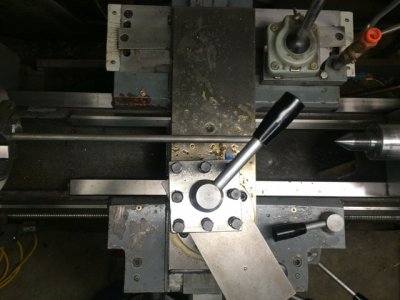Hi Dave, thank you for the picture of your set up. That is a very, very flexible set up (even though you are only threading a couple inches from the tailstock support).
There is usually more than one way to set up a job. I would normally have the theading tool on the left side of the toolpost, which would allow you to work in much closer to the chuck. With that size of stock, you will need tailstock support if you are out from the chuck more than about 1”. True, this means you will be threading in close to a spinning chuck – that is called machining.
Backlash in the carriage hand wheel will not effect your thread. The leadscrew/half nut works like a bolt & nut to pull the carriage along. The carriage feed and hand wheel have nothing to do with threading.
The issue with threading (and a number of other types of operations) is that the width of cut will get wide (the full width of the flank of the thread). One of the things which took me a long time to appreciate is the concept of rigidity (or flexibility).
Nothing in machining is truly solid. You need to do the best you can to make your set up rigid, then compensate for the flexibility.
The reason for the 29° (or 29.5° or 30° - depending on who you talk to, there really is a reason for each of those. I go with 29°) is so that you are mainly cutting on just one flank. Of course you can simply plunge cut with the cross slide – that is fine if your set up is stiff enough, but then the cut is twice the width.
I recently completed a lead screw (15.75” of ¾” NC thread) – see my posts elsewhere. A ¾” NC thread has quite a wide flank as it approaches full depth. With this long thread, there is quite a bit of deflection (~0.003”at the mid-point) of the work piece and guaranteed chatter even with a very small depth of cut.
I acknowledge that you would like to sort out one good method for a certain procedure, such as threading by fwd/rev your machine and leave the half nuts closed. That approach does not work very well for machining when every job will be different and present new challenges.
In fact, even on an imperial machine, when cutting a metric thread you can still open/close the half nut (described in an old MW magazine – I can dig it up and post the reference). I don’t cut many metric threads so for that occasional job I use the procedure of keeping the half nuts closed and reversing the machine. The point being that as you gain expertise you will learn lots of strategies for getting great results.
 Steve Shannon, P.E.
Steve Shannon, P.E. 
 Steve Shannon, P.E.
Steve Shannon, P.E. 


